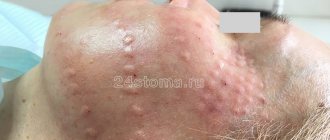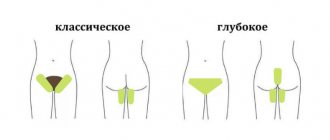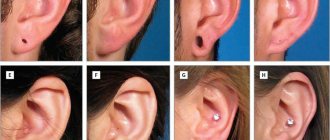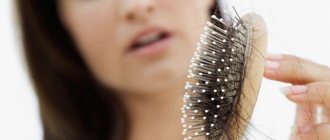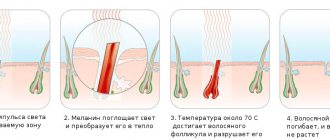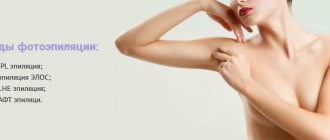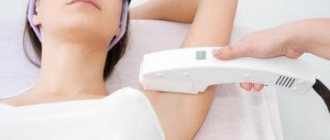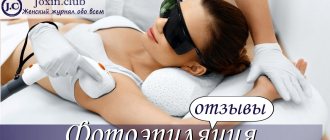Read in this article:
- What is photoepilation and how does it work?
- Advantages and disadvantages of the method
- Can light hair removal cause harm?
- How to choose a photoepilator?
- How to use a home photoepilator?
- Photoepilator: convenience and efficiency
Photoepilation is a modern and very effective method of hair removal. The technique appeared relatively recently, so it still raises many questions about the harm to the body, the peculiarities of the procedure, and how long the results will last. We understand all the nuances and advantages of this method.
What is photoepilation and how does it work?
Photoepilation is a hardware method of hair removal using light rays, which is why it is also called light hair removal. The basic principle is the effect on the pigment melanin, which is found in the skin and hair, has the ability to absorb and conduct light, and convert it into heat. As a result, the hair itself heats up to a temperature of 70-80°C, blood clots in the capillaries closest to it, and nutrition of the follicle stops. Because of this, the hair follicle dies.
The light pulse affects only those follicles that are currently in the growth phase. The procedure does not affect dormant hair follicles, but hair can begin to grow from them at any time. That is why several sessions are held at a certain period of time.
Understanding the essence of the effect, it is easy to understand how the photoepilator works. Such devices were previously used only in the salon, but now it is quite possible to carry out the procedure at home.
Each such device has a built-in lamp that sends a light pulse in the form of a flash of the set power. This technology is called IPL (Intensive Pulse Light or impulsive pulsed light).
Efficiency of the procedure
The high efficiency of the photoepilation technique has been proven by many years of experience in its use. People who have tried it note the absence of side effects, and after 4-5 procedures, the majority report an almost complete disappearance of the growth of unwanted hairs on the body.
It is important to note that during the first procedure, the flash affects only the roots; the hair shafts themselves are not destroyed. That is why, after two weeks, the hairs fall out on their own.
After three or four procedures, the vegetation on the human body is halved, grows more slowly, and becomes less dense.
Advantages and disadvantages of the method
Before deciding on such a procedure, it is worth studying all its pros and cons. The main advantages of photoepilation include:
- Hygienic – during hair removal the device does not come into contact with the skin, so the transmission of harmful microorganisms through it is excluded;
- The procedure is carried out quite quickly, does not require a significant investment of time, the device acts on a large area of skin;
- The result lasts for a long time, and many hairs stop growing forever;
- There is an opportunity to save on the purchase of razors, depilatory creams, sugaring paste, wax strips;
- The use of a photoepilator is possible on any part of the body, including areas with thin and sensitive skin;
- Light waves stimulate the production of collagen, so the skin becomes more elastic and its regeneration processes are activated;
- The first results are noticeable almost immediately;
- There is no pain or discomfort even with a low pain threshold;
- During the procedure, the skin is not damaged, so the risk of infection is reduced to zero;
- The appearance of ingrown hairs is excluded.
The main disadvantage of photoepilation is related to the principle of its action. Light radiation cannot affect hairs that contain little or no melanin. For this reason, the procedure is not suitable for very light and gray hair.
The second nuance is the melanin content in the skin. Under the influence of sunlight, the pigment concentration increases and the skin darkens. That is why before the procedure you will have to avoid visiting the beach and solarium for several weeks.
The downside is the need for several sessions, with a significant break, in order to achieve truly smooth skin. In addition, there is a recovery period: for a week after using a home photoepilator, you should not visit the sauna or apply cosmetics to the corresponding area.
Post-procedure care
A completely normal reaction of the skin to such an external irritant as UV rays is the appearance of slight redness, swelling, and peeling in the area of hair removal procedures. Moreover, if you follow some recommendations, the skin will recover within a week.
After the hair removal procedure, it is recommended to apply a special cream that will not only soothe the skin, but also moisturize it.
For one day after photoepilation, it is highly undesirable to take a bath, take a cold or too warm shower, wear tight-fitting clothes in contact with the treated area, or use any cosmetics other than moisturizer.
From the first to the last session, it is prohibited to go to the solarium, sunbathe on the beach, or remove hair by any other method other than shaving. Moreover, for two weeks, the use of sunscreen is highly recommended if the skin is not covered with clothing.
If severe redness or burning is observed after the manipulation, the use of any anti-burn medication is recommended.
Can light hair removal cause harm?
Many girls are interested in why light hair removal is harmful and whether it has a negative effect on the body. In fact, the procedure is safe and does not cause any harm if you follow the rules for operating the device and preparing for hair removal.
Home photoepilators do not have such power that there is a risk of serious burns. However, on tanned skin, the light pulse can cause hyperpigmentation.
Photoepilation has a number of contraindications. The procedure cannot be performed if:
- Allergic skin reactions;
- Dermatological diseases;
- Complicated form of diabetes;
- Chronic arterial hypertension, cardiac ischemia;
- The presence of malignant neoplasms on the skin;
- Open form of herpes;
- Increased sensitivity of the epidermis to solar radiation.
This type of epilator should not be used by people with epilepsy and mental illness, impaired blood clotting, in a feverish state, or with severe varicose veins. If there are abrasions, burns or wounds on the skin, the procedure should be postponed, otherwise scars may form.
Who should not undergo photoepilation?
Despite the safety of photoepilation, it has contraindications. It is important to follow them, otherwise there is a risk of problems with the girl’s health or a decrease in the effectiveness of the procedure.
There are many health restrictions for using a photoepilator:
- Diabetes;
- Vascular diseases;
- Venous dilatations;
- Dermatological diseases;
- Infectious and chronic diseases;
- Tumors;
- Open skin lesions;
- Pathologies of internal organs.
Is photoepilation harmful? High-pulse light or heat flashes can adversely affect your health after the session if you have one of the diseases on the list of contraindications.
Most often, photoepilation does not cause pain to girls, but during the session they may experience discomfort associated with a sudden surge of heat to the treated area, tingling or even burning. But if you are afraid of pain during work, the procedure should be performed after menstruation. At this time, the pain threshold is increased, which is why it is not necessary to use an anesthetic.
Also, girls with hypersensitive skin often have an allergic reaction to the gel used for photoepilation, so first make sure there is no reaction.
How to choose a photoepilator?
When choosing a device, you should immediately decide what the photoepilator is for. The optimal characteristics of the device are determined by the areas in which it is planned to be used. A device of any size is suitable for home use, but for traveling you should choose a compact model.
It is worth paying attention to several main characteristics:
- Light spot area - each flash covers an area of a certain area. The larger the light spot, the faster the procedure can be carried out;
- Lamp life is the number of flashes after which the lamp will need to be replaced. If you plan to treat large areas of skin, it is better to choose models with a long service life;
- Degrees of protection - many modern models are equipped with a function that provides a light pulse only when in close proximity to the skin. There are options with protection against accidental pressing when directed into the eyes;
- Power type - devices with a battery are more mobile, but they have a longer interval between flashes. Models powered by the network work quickly and continuously.
It is advisable to choose a device with a UV filter that protects against the negative effects of ultraviolet rays. It is very convenient if the device can adjust the flash intensity. Additional protection will be provided by a sensor that blocks flashes on dark skin to prevent burns.
What is laser hair removal?
It’s easy to guess from the name that in this case a laser is used, the light energy of which is converted into heat, which purposefully destroys the hair follicle. In this case, the beam is precisely absorbed directly by the hair, without affecting the skin. This precision of action allows not to injure even the most sensitive dermis. For maximum comfort during the session, some units are equipped with a built-in cooling system. This will please those who want to know in advance what is more painful: laser hair removal or photoepilation? It is the built-in skin cooling system that allows us to claim that this procedure is less painful than photo- or electrolysis. You can find out more about the procedure in the “here” section.
How to use a home photoepilator?
Preparing for home photoepilation involves studying the instructions. If the procedure is carried out for the first time, also protect the skin from sunburn. The minimum hair length must be 3 mm, otherwise the impulse simply will not work. To remove hair you need:
- Turn on the device and bring it closer to the skin, paying attention to the indicators;
- Apply a special gel that scatters the rays;
- Run the device along the surface to be treated horizontally at an angle of 45°;
- When the device beeps, move it to the next area.
If after photoepilation a tingling feeling appears, small red spots appear on the skin, there is no need to be alarmed: this is a normal phenomenon that quickly goes away on its own. It is not recommended to apply greasy cream to the skin, as it impedes the supply of oxygen to the skin. After the procedure, additional hydration is necessary to avoid dry skin, so you need to drink at least 1.5 liters of water per day. The hot bath will have to be temporarily replaced with a cool shower.
Possible complications
The safety of the procedure is ensured only if the contraindications and recommendations prescribed for it are fully observed. However, there are also consequences of photoepilation, which can be reflected in its effectiveness or the girl’s health.
The main consequences of photoepilation:
- Thermal burn. Occurs when the procedure is performed incorrectly;
- Skin irritation and inflammation. It is usually associated with the client’s failure to comply with recommendations for preparation for the session, as well as care after it;
- Complications of diseases that the girl had before visiting the salon;
- Reduced effectiveness of the procedure;
- Pigmentation;
- Scar formation.
After photoepilation, the skin may experience itching and tingling for several hours; such side effects are quite common. Lubricate the skin with Bepanten or Panthenol to speed up the restoration of the epidermis.
Photoepilator: convenience and efficiency
To decide whether to buy a photoepilator for home, it is enough to study the advantages of this procedure and make sure there are no contraindications. Such a device will allow you to get rid of excess hair for a long time, ensure safety and absence of pain, and also help make your skin more elastic and firm.
Before and after photos, video
The degree of effectiveness of the method can be judged by looking at many photos before and after the procedure.
Information about photoepilation of the upper lip, neck, armpits or any other area can be found by watching the suggested videos.
There are many ways to get rid of unnecessary hair on the body. However, one of the most effective and safest techniques is photoepilation.
Is it possible to carry out photoepilation at home?
Even if the patient independently realized that he has no contraindications to the procedure and decided to buy a home device, it is still necessary to visit a cosmetologist to clarify the nuances and details. After receiving all the recommendations, you can proceed to preparing the skin:
- stop taking antibiotics that increase skin sensitivity to light (indicated in the instructions), do not visit solariums, do not go to the beach for 7-10 days;
- two days in advance, you need to shave the hair in the area using a razor where photoepilation will be carried out;
- prepare the device by charging it and adjusting it for a specific skin type;
- Protect your eyes from radiation with special glasses.
The price varies between 12-40 thousand rubles, it all depends on the manufacturer, model of the device and the store that makes the markup.
Photoepilation and laser hair removal: comparison
Both methods are designed for radical hair removal from a particular surface using light radiation. Such similarities often confuse the patient: what is better – photoepilation or laser hair removal. To answer this question, you need to clarify the differences between these methods:
- duration – photoepilation lasts less time than laser removal;
- number of procedures – laser requires fewer visits;
- discomfort – hair removal using photoepilation brings much less pain;
- treatment area – one flash during laser hair removal covers a smaller area of skin;
- possible limitations - photoepilation is less effective when removing light hair on light skin.
Both methods have their pros and cons; the type of procedure is determined by the doctor after diagnosis.
Answers to popular questions
- How much is enough?
The timing depends on the individual characteristics of the body, for example, gender, functioning of the endocrine system, age and other factors. After a full course of photoepilation, a woman’s hair does not grow from six months to 5-7 years.
- Is photoepilation painful?
It all depends on the location of the epilation area and the patient’s pain threshold, however, in most cases, only mild discomfort occurs. All sensations are tolerable and do not require the administration or application of anesthetics.
- How many sessions are needed?
For the most effective removal, you need to carry out a certain number of procedures. The more delicate the skin, the fewer there should be. Usually 3 to 10 procedures are prescribed; before the next hair removal you need to wait 3-4 weeks. One session lasts about 60-90 minutes, time intervals are also individual.
- For what hair is photoepilation suitable?
Thanks to good modern equipment, our specialists get rid of hair, regardless of skin and hair color. However, it has been noted that in the presence of light, red, gray hair, and dark skin, photoepilation is less effective. For such patients, it is better to choose the ELOS hair removal system or the alexandrite type of laser.
- Can it be done in a deep bikini area?
Dermatologists and cosmetologists claim that photo hair removal is the safest manipulation that does not have a negative effect on the human body with due professionalism and correct equipment settings.
Reviews
Reviews from cosmetologists are positive. Experts say that thanks to modern technologies, the procedure has become safer, more comfortable and at the same time most effective. If hair removal does not bring the desired result, it is advisable to check your hormonal profile.
Patient reviews on thematic sites vary, but the majority are glad that they have finally gotten rid of their cosmetic problem. Some report unpleasant but tolerable sensations.
Price
Multidisciplinary medical service has an affordable pricing policy. A doctor’s consultation on photoepilation is absolutely free; our professionals will explain whether removal is possible and within what time frame. Hair removal is performed on the following areas of the body:
- upper lip;
- chin;
- neck;
- cheeks;
- forehead;
- armpits;
- breast;
- neckline;
- bikini;
- back;
- arms and legs.
Prices for photoepilation in Moscow differ; how much one session costs can be found on our official website.
Are there any contraindications for the procedures?
The contraindications for both procedures will be almost the same. A session will not be scheduled for any chronic or acute skin diseases or if there is damage or irritation on its surface. The session is contraindicated for inflammatory processes in the acute stage occurring in the body. Also, both procedures are contraindicated if the patient has diabetes, varicose veins, or any heart or cancer diseases. Exposure to krypton lamps is also contraindicated if there are tumors or tattoos on the surface of the body.
The cosmetologists of the NEOMED clinic are always ready to advise you, answer all your questions and choose the most suitable method for you.
Which equipment to choose?
NEOMED Clinic cares about its clients and chooses the leading equipment for removing unwanted hair. The GentleLASE system manufactured by Candela (USA) is equipped with a unique “DCD” dynamic skin cooling system, which cannot be found in other devices. This system is recognized as the most effective and safe in cosmetology. Cooling makes the procedure as painless as possible at the moment when the beam completely destroys the follicle. You will only have those hairs that have not yet appeared above the surface of the skin.
You can find out more about the procedure in the “here” section.
First result and number of required sessions.
Laser hair removal.
The result is noticeable after the first procedure; on days 5-8, hair begins to actively fall out and the growth of new hairs significantly decreases.
The average course of laser hair removal is 4-6 procedures. But it all depends on the device (at Epimed we use the Lightsheer Duet device, which allows you to get rid of unwanted hair for up to 7 years in 3-5 sessions) and individual characteristics.
Photoepilation.
After photoepilation, the result is also visible after the first session. Hair begins to fall out after 1-2 weeks. The activity of new hair growth also decreases.
The course of photoepilation, also depending on the device (we use Lumenis M22), is approximately 6-10 sessions. The intervals between sessions increase as hair growth stops.
Which method is more effective?
The main goal of both methods is to remove unwanted hair for a long time or permanently. Therefore, when comparing the effectiveness of both procedures, we rely on an assessment of the final result. Both methods will cause the bulk of the hair to gradually disappear. However, the result will depend on the selected area of the body, the color of the skin, and the amount of visible and not yet grown hair.
Of course, a huge role is played by such factors as maximum removal in one session, the depth of impact with the death of follicles, their uniform destruction on any part of the body, comfort during the procedure, the number of repeated procedures and the duration of the period when hair does not grow.
Summarizing all the main differences between both methods, it can be argued that laser hair removal is of higher quality, because you will only have those hairs that have not yet appeared above the surface of the dermis. You will need fewer treatments until the hairs stop growing altogether. This method is successfully used on any part of the body and is much more comfortable. The high cost of one session is offset by fewer repeat procedures, resulting in you paying the same amount of money.
Photoepilation can often destroy not all hairs down to the follicle in one flash, especially in the bikini area or armpits, where there are depressions. It is also difficult to treat small areas of the body, such as the upper lip. And the sensitivity of the intimate area may be a limitation to the procedure. Therefore, we can say that laser hair removal is most effective.
If you want to try both options for yourself and draw your own conclusions, then try one of them first, for example, laser. Ask your cosmetologist the following question: “Is it possible to do photoepilation after this and after what time?” As a rule, it is enough to wait until new “dormant” hairs grow. But having tried the action of the Gentle LASE Candela laser (“gentle laser”), our clients are completely satisfied with both the result and the progress of the procedure itself!

